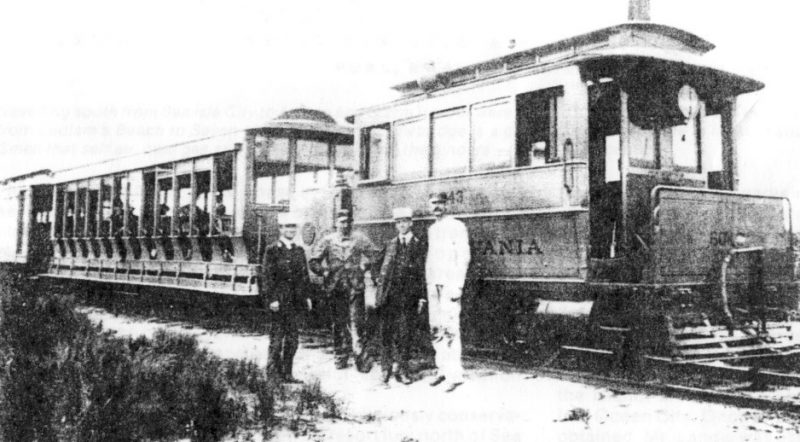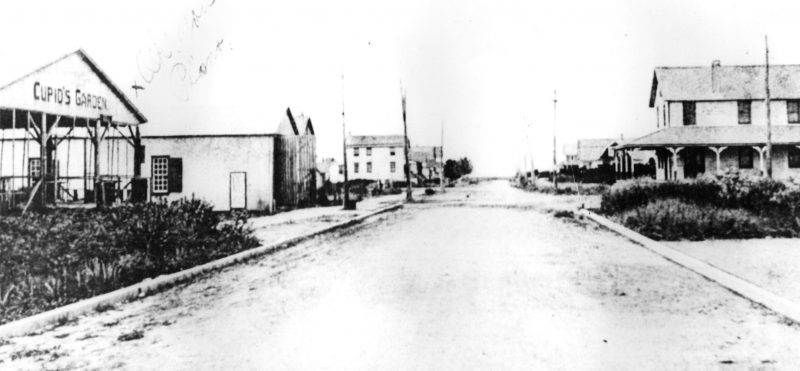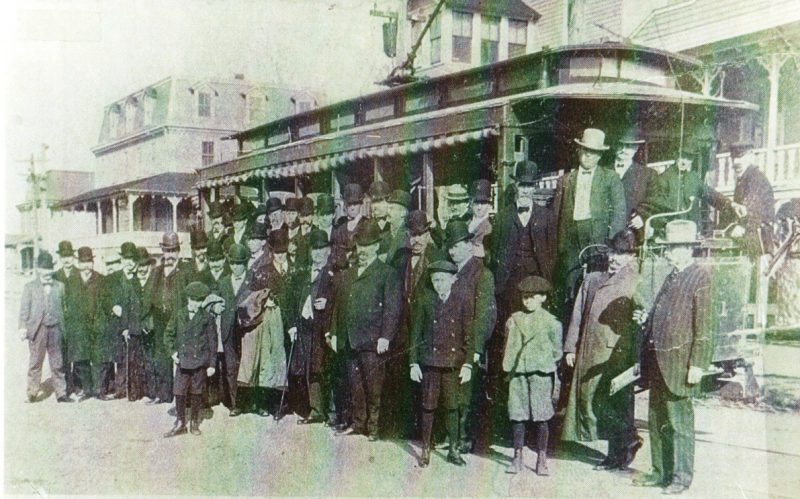 The Sea Isle Trolley:
The Sea Isle Trolley:
Sea Isle grew at an amazing pace during the 1880s and 1890s. With all the new hotels, businesses, and entertainment venues throughout the town, along with multiple spots for beach and fishing access, versatile travel became a necessity. A trolley was seen as the perfect vehicle to fill that need.
Sea Isle hasn’t seen formal trolley service in more than a hundred years. Yet it was once considered
the essential means of transport from one end of the island to the other. It began boldly in 1887 with two systems, and ended with an economic whimper in 1917 – after a 30-year lifetime of service.
The Pleasure Avenue “Trolley”
In 1887 the West Jersey Railroad announced that commencing July 2, "Horse cars will be run on the (existing) Pleasure Railroad between Sea Isle City and Townsend's Inlet." The trip along present-day Pleasure Avenue was to take about 20 minutes and the fare would be 10 cents. The schedule called for 17 round trips per day. When the railroad line was extended to the north end of the island, one could travel as far as Corson’s Inlet in a horse car. Although not formally called a "trolley," these cars served the same purpose: to provide local service to the town’s hotels and to deliver travelers to the train station on JFK Boulevard. (It’s hard to see how those horses could make the trip in just 20 minutes.)

The West Jersey Horse Car schedule.
It isn’t clear what that very first horse car looked like, but there's indication that it was an early version of the "Yellow Kid." The original Kid was an old Ocean City railroad workman’s car painted yellow, with the innards removed and benches added. It was at first pulled by animals of some kind, then engine-propelled. It was disguised as a trolley so it wouldn’t frighten visitors, or more importantly, their horses. In 1895 the motorized Yellow Kid began service between Stone Harbor and Ocean City. It ran this route for about eight years, and then was replaced by standard locomotives.
The First Landis Avenue Trolley
In 1887, a second trolley service – this time along Landis Avenue – was initiated between Townsend’s Inlet and downtown Sea Isle, and later Strathmere. The cars were propelled by mules with a stable for the animals located at line's end on 85th Street – the site of the present Townsend's Inlet Civic Center. The first Landis Avenue trolley was the direct predecessor of the system described below.
These early trolley systems must have been quite a sight. The driver sometimes wore a railroad cap decorated with gold braid; the ladies would usually carry parasols; the men might even bring along their fishing gear; and all would usually dress in formal outfits – including hats for both men and women.

The electrified trolley.
The Electrified Trolley on Landis Avenue
In 1904, the New Jersey Rapid Transit Company (NJRT) began to operate an electric-powered street railway – a genuine trolley as we know it – along the same route as its predecessor, initially terminating at the Continental Hotel at 25
th Street, then ultimately at Corson’s Inlet. A trolley barn replaced the animal stable used for the earlier trolley at the T.I. Civic Center location.
The railway was a seasonal operation which ran only during the summer months. It used six cars, each seating 40 passengers and all open to the pleasant summer breezes. One of the more popular destinations was Cupid’s Garden at the south end of the line. With Busch’s and other restaurants nearby, people could enjoy a seafood dinner, stroll over to Cupid’s Garden to dance to live music, then hop on the trolley back to the city. It was a great way for visitors and locals to get around.

Cupid's Garden was a source of entertainment.
The End of an Era
The New Jersey Rapid Transit Company never seemed to be on firm financial footing with its trolley. It began by issuing $200,000 in 30-year bonds which unfortunately outlasted the life of the company by more than a decade. Things went well at first. Then Henry Ford’s motorcar and World War I delivered a one-two punch: ridership and revenue declined, upkeep was neglected, and supplies became difficult to come by.
In 1917 the Public Utilities Commission refused to let the trolley line operate unless extensive repairs were carried out and new cars purchased. The company responded that they could not afford it. As a result, the line was shut down, their charter voided, the trolley barn sold with the idea of converting it to an automobile repair shop – and Sea Isle City's old-time trolley era came to an end.
In 2010, when road repairs were being conducted along Landis Avenue, remnants of trolley track ties were unearthed. They were speaking to us from nearly 100 years ago.
(Now, after waiting a century, a new kind of trolley era may have begun. A few years ago, the city initiated the Jitney on Landis Avenue. This popular service mirrors in many ways the operation of the early street railway. We seem to have come full circle – from trolleys, to automobiles, to too many automobiles, and back to the use of the trolley-like Jitney.)

A trolley party in Sea Isle.
Please visit the Sea Isle City Historical Museum at 48th Street and Central Avenue. We have, in addition to literature about the trolley, an original trolley bell which is mounted so that visitors can ring it and experience the echo of our history. Access our website at www.seaislemuseum.com. Call 609-263-2992 with any questions. Current hours are 10:00am – 3:00pm Monday, Tuesday, Thursday, and Friday.
 The Sea Isle Trolley:
Sea Isle grew at an amazing pace during the 1880s and 1890s. With all the new hotels, businesses, and entertainment venues throughout the town, along with multiple spots for beach and fishing access, versatile travel became a necessity. A trolley was seen as the perfect vehicle to fill that need.
Sea Isle hasn’t seen formal trolley service in more than a hundred years. Yet it was once considered the essential means of transport from one end of the island to the other. It began boldly in 1887 with two systems, and ended with an economic whimper in 1917 – after a 30-year lifetime of service.
The Pleasure Avenue “Trolley”
In 1887 the West Jersey Railroad announced that commencing July 2, "Horse cars will be run on the (existing) Pleasure Railroad between Sea Isle City and Townsend's Inlet." The trip along present-day Pleasure Avenue was to take about 20 minutes and the fare would be 10 cents. The schedule called for 17 round trips per day. When the railroad line was extended to the north end of the island, one could travel as far as Corson’s Inlet in a horse car. Although not formally called a "trolley," these cars served the same purpose: to provide local service to the town’s hotels and to deliver travelers to the train station on JFK Boulevard. (It’s hard to see how those horses could make the trip in just 20 minutes.)
The Sea Isle Trolley:
Sea Isle grew at an amazing pace during the 1880s and 1890s. With all the new hotels, businesses, and entertainment venues throughout the town, along with multiple spots for beach and fishing access, versatile travel became a necessity. A trolley was seen as the perfect vehicle to fill that need.
Sea Isle hasn’t seen formal trolley service in more than a hundred years. Yet it was once considered the essential means of transport from one end of the island to the other. It began boldly in 1887 with two systems, and ended with an economic whimper in 1917 – after a 30-year lifetime of service.
The Pleasure Avenue “Trolley”
In 1887 the West Jersey Railroad announced that commencing July 2, "Horse cars will be run on the (existing) Pleasure Railroad between Sea Isle City and Townsend's Inlet." The trip along present-day Pleasure Avenue was to take about 20 minutes and the fare would be 10 cents. The schedule called for 17 round trips per day. When the railroad line was extended to the north end of the island, one could travel as far as Corson’s Inlet in a horse car. Although not formally called a "trolley," these cars served the same purpose: to provide local service to the town’s hotels and to deliver travelers to the train station on JFK Boulevard. (It’s hard to see how those horses could make the trip in just 20 minutes.)
 The West Jersey Horse Car schedule.
It isn’t clear what that very first horse car looked like, but there's indication that it was an early version of the "Yellow Kid." The original Kid was an old Ocean City railroad workman’s car painted yellow, with the innards removed and benches added. It was at first pulled by animals of some kind, then engine-propelled. It was disguised as a trolley so it wouldn’t frighten visitors, or more importantly, their horses. In 1895 the motorized Yellow Kid began service between Stone Harbor and Ocean City. It ran this route for about eight years, and then was replaced by standard locomotives.
The First Landis Avenue Trolley
In 1887, a second trolley service – this time along Landis Avenue – was initiated between Townsend’s Inlet and downtown Sea Isle, and later Strathmere. The cars were propelled by mules with a stable for the animals located at line's end on 85th Street – the site of the present Townsend's Inlet Civic Center. The first Landis Avenue trolley was the direct predecessor of the system described below.
These early trolley systems must have been quite a sight. The driver sometimes wore a railroad cap decorated with gold braid; the ladies would usually carry parasols; the men might even bring along their fishing gear; and all would usually dress in formal outfits – including hats for both men and women.
The West Jersey Horse Car schedule.
It isn’t clear what that very first horse car looked like, but there's indication that it was an early version of the "Yellow Kid." The original Kid was an old Ocean City railroad workman’s car painted yellow, with the innards removed and benches added. It was at first pulled by animals of some kind, then engine-propelled. It was disguised as a trolley so it wouldn’t frighten visitors, or more importantly, their horses. In 1895 the motorized Yellow Kid began service between Stone Harbor and Ocean City. It ran this route for about eight years, and then was replaced by standard locomotives.
The First Landis Avenue Trolley
In 1887, a second trolley service – this time along Landis Avenue – was initiated between Townsend’s Inlet and downtown Sea Isle, and later Strathmere. The cars were propelled by mules with a stable for the animals located at line's end on 85th Street – the site of the present Townsend's Inlet Civic Center. The first Landis Avenue trolley was the direct predecessor of the system described below.
These early trolley systems must have been quite a sight. The driver sometimes wore a railroad cap decorated with gold braid; the ladies would usually carry parasols; the men might even bring along their fishing gear; and all would usually dress in formal outfits – including hats for both men and women.

 Cupid's Garden was a source of entertainment.
The End of an Era
The New Jersey Rapid Transit Company never seemed to be on firm financial footing with its trolley. It began by issuing $200,000 in 30-year bonds which unfortunately outlasted the life of the company by more than a decade. Things went well at first. Then Henry Ford’s motorcar and World War I delivered a one-two punch: ridership and revenue declined, upkeep was neglected, and supplies became difficult to come by.
In 1917 the Public Utilities Commission refused to let the trolley line operate unless extensive repairs were carried out and new cars purchased. The company responded that they could not afford it. As a result, the line was shut down, their charter voided, the trolley barn sold with the idea of converting it to an automobile repair shop – and Sea Isle City's old-time trolley era came to an end.
In 2010, when road repairs were being conducted along Landis Avenue, remnants of trolley track ties were unearthed. They were speaking to us from nearly 100 years ago.
(Now, after waiting a century, a new kind of trolley era may have begun. A few years ago, the city initiated the Jitney on Landis Avenue. This popular service mirrors in many ways the operation of the early street railway. We seem to have come full circle – from trolleys, to automobiles, to too many automobiles, and back to the use of the trolley-like Jitney.)
Cupid's Garden was a source of entertainment.
The End of an Era
The New Jersey Rapid Transit Company never seemed to be on firm financial footing with its trolley. It began by issuing $200,000 in 30-year bonds which unfortunately outlasted the life of the company by more than a decade. Things went well at first. Then Henry Ford’s motorcar and World War I delivered a one-two punch: ridership and revenue declined, upkeep was neglected, and supplies became difficult to come by.
In 1917 the Public Utilities Commission refused to let the trolley line operate unless extensive repairs were carried out and new cars purchased. The company responded that they could not afford it. As a result, the line was shut down, their charter voided, the trolley barn sold with the idea of converting it to an automobile repair shop – and Sea Isle City's old-time trolley era came to an end.
In 2010, when road repairs were being conducted along Landis Avenue, remnants of trolley track ties were unearthed. They were speaking to us from nearly 100 years ago.
(Now, after waiting a century, a new kind of trolley era may have begun. A few years ago, the city initiated the Jitney on Landis Avenue. This popular service mirrors in many ways the operation of the early street railway. We seem to have come full circle – from trolleys, to automobiles, to too many automobiles, and back to the use of the trolley-like Jitney.)
 A trolley party in Sea Isle.
Please visit the Sea Isle City Historical Museum at 48th Street and Central Avenue. We have, in addition to literature about the trolley, an original trolley bell which is mounted so that visitors can ring it and experience the echo of our history. Access our website at www.seaislemuseum.com. Call 609-263-2992 with any questions. Current hours are 10:00am – 3:00pm Monday, Tuesday, Thursday, and Friday.
A trolley party in Sea Isle.
Please visit the Sea Isle City Historical Museum at 48th Street and Central Avenue. We have, in addition to literature about the trolley, an original trolley bell which is mounted so that visitors can ring it and experience the echo of our history. Access our website at www.seaislemuseum.com. Call 609-263-2992 with any questions. Current hours are 10:00am – 3:00pm Monday, Tuesday, Thursday, and Friday.